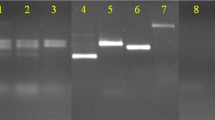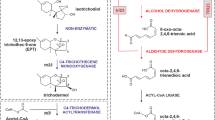Abstract
A trichodiene synthase gene (Tri5) was amplified from F. poae by polymerase chain reaction using synthetic primers constructed on the basis of the coding portion of the same gene from F. sporotrichioides. Sequence analysis showed a high degree of similarity with other trichodiene synthase genes. A 378 bp HindIII fragment of the gene that contains the genetic information for the putative active site of the trichodiene synthase enzyme was radiolabelled and used for dot blot analysis. This probe could detect Tri5 hybridization in 1-10 ng DNA of fusaria that have the genetic potentiality to synthesize toxic trichothecene compounds, but gave no reaction with trichothecene nonproducing members of the genus. When other fungi reported to produce trichothecenes (Myrothecium, Stachybotrys, Trichoderma, Trichothecium spp.) were tested, only strains of Myrothecium and Stachybotrys gave strong positive reaction. Faint but consistent hybridization signals were obtained in four species (F. semitectum, F. tricinctum, Trichoderma viride and Trichothecium roseum) indicating the presence of nonhomologous evolutionary variants or inactive remnants of the Tri5 gene in these fungi.
Similar content being viewed by others
References
Mirocha CJ, Pathre SV, Pawlosky RJ, Hewetson DW. Mass spectra of selected trichothecenes. In: Cole RJ, ed. Modern Methods in the Analysis and Structural Elucidation of Mycotoxins. New York: Academic Press, 1986: 353–392.
Marasas WFO, Nelson PE, Toussoun TA. Toxigenic Fusariumspecies. Identity and Mycotoxicology. University Park/London: The Pennsylvania State University Press, 1984.
Scott PM, Harwing J, Blanchfield BJ. Screening Fusariumstrains isolated from overwintered Canadian grains for trichothecenes. Mycopathologia 1980; 72: 175–180.
Mirocha CJ, Pathre SV, Schauerhamer B, Christensen CM. Natural occurrence of Fusariumtoxins in feedstuff. Appl Environ Microbiol 1976; 32: 553–556.
Yoshizawa T, Morooka N. Trichothecenes from mold-infested cereals in Japan. In Rodricks JV, Hesseltine CW, Mehlman MA, ed, Mycotoxins in Human and Animal Health. Park Forest South: Pathotox Publishers, Inc, 1977; 309–321.
Hohn TM, Beremand PD. Isolation and nucleotide sequence of a sesquiterpene cyclase gene from the trichothecene producing fungus Fusarium sporotrichioides. Gene 1989; 79: 131–138.
Hohn TM, Desjardins AE. Isolation and gene disruption of the Tox5 gene encoding trichodiene synthase in Gibberella pulicaris. Mol Plant-Microbe Interact 1992; 5: 249–256.
Proctor RH, Hohn TM, McCormick SP. Reduced virulence of Gibberella zeaecaused by disruption of a trichothecene toxin biosynthetic gene. Mol Plant-Microbe Interact 1995; 8: 593–601.
Parry DW, Jenkinson P, McLeod L. Fusariumear blight (scab) in small grain cereals – a review. Plant Pathol 1995; 45: 383–391.
Tóth A, Barna-Vetró I, Gyöngyösi Á, Pomázi A, Szécsi Á, Hornok L. Prevalence and mycotoxin production of Fusariumspecies isolated from wheat grains in Hungary. Acta Phytopath Entomol Hung 1993; 28: 3–12.
Wilcoxson RD, Kommedahl T, Ozmon EA, Windels CE. Occurrence of Fusariumspecies in scabby wheat from Minnesota and their pathogenicity to wheat. Phytopathology 1988; 78: 586–589.
Thrane U. Fusariumspecies and their specific profiles of secondary metabolites. In: Chelkowski J, ed. FusariumMycotox97 ins, Taxonomy and Pathogenicity. Amsterdam: Elsevier, 1989: 199–225.
Pettersson H, Olvang H. Trichothecene production by Fusarium poaeand its ecology. Abstracts of the International Seminar on FusariumMycotoxins, Taxonomy and Pathogenicity, Martina Franca, Italy, 1995; p. 178.
Fekete C, Giczey g, Papp I, Szabó L, Hornok L. Highfrequency occurrence of virus-like particles with doublestranded RNA genome in Fusarium poae. FEMS Microbiol Lett 1995; 131: 295–299.
Saiki RK, Gelfand DH, Stoffel S, Scharf SJ, Higuchi R, Horn GT, Mullis KB, Erlich, HA. Primer-directed enzymatic ampli-fication of DNA with thermostable polymerase. Science 1988; 239: 487–491.
Marchuk D, Drumm M, Saulino A, Collins SF. Construction of T-vectors, a rapid and general system for direct cloning of unmodified PCR products. Nucleic Acids Res 1991; 19: 1154.
Sanger F, Nicklen S, Coulson AR. DNAsequencingwith chainterminating inhibitors. Proc Natl Acad Sci USA 1977; 74: 5463–5467.
Devereux J, Haeberli P, Smithies O. A comprehensive set of sequence analysis programs forVAX. Nucleic Acids Res 1984; 12: 387–395.
Southern EM. Detection of specific sequences among DNA fragments separated by gel electrophoresis. J Mol Biol 1975; 98: 503–517.
Fekete C, Nagy R, Debets AJM, Hornok L. Electrophoretic karyotypes and gene mapping in eight species of the Fusariumsections Arthrosporiella and Sporotrichiella. Curr Genet 1993; 24: 500–504.
Mirocha CJ, Abbas HK, Windels CE, Xie W. Variation in deoxynivalenol, 15-acetyldeoxynivalenol, 3-acetyldeoxynivalenol, and zearalenone production by Fusarium graminearumisolates. Appl Environ Microbiol 1989; 55: 1315–1316.
Nagy R, Táborhegyi é, Wittner A, Hornok L. Minichromosomes in Fusarium sporotrichioidesare mosaics of dispersed repeats and unique sequences. Microbiology 1995; 141: 713–719.
Thrane U. Detection of toxigenic Fusariumisolates by thin layer chromatography. Lett Appl Microbiol 1986; 3: 93–96.
Cane DE, Shim JH, Xue Q, Fitzsimons BC. Trichodiene synthase. Identification of active site residues by site-directed mutagenesis. Biochemistry 1995; 34: 2480–2488.
Jarvis BB, Stahly GP, Pavanasasivam G, Mazzola EP. Structure of roridin J, a new macrocyclic trichothecene fromMyrothecium verrucaria. J Antibiot 1980; 33: 256–258.
Sorenson WG, Sneller MR, Larsh HW. Qualitative and quantitative assay of trichothecin: a mycotoxin produced by Trichothecium roseum. Appl Microbiol 1975; 29: 653–657.
Boheim G, Irmscher G, Jung G. Trichotoxin A-40, a new membrane-exciting peptide. Part B. Voltage-dependent pore formation in bilayer lipidmembranes and comparisonwith other alamethicin analogues. Biochim Biophys Acta 1978; 507: 485–506.
Miller JD, Greenhalgh R, Wang Y, Lu M. Trichothecene chemotypes of three Fusariumspecies. Mycologia 1991; 83: 121–130.
Logrieco A, Altomare C, Moretti A, Bottalico, A. Cultural and toxigenic variability in Fusarium acuminatum. Mycol Res 1992; 96: 518–523.
Proctor RH, Hohn, TM, McCormick, SP, Desjardins AE. Tri6encodes an unusual zinc finger protein involved in regulation of trichothecene biosynthesis in Fusarium sporotrichioides. Appl Environ Microbiol 1995; 61: 1923–1930.
Desjardins AE, Hohn TM, McCormick SP Effect of gene disruption of trichodiene synthase on the virulence of Gibberella pulicaris. Mol Plant-Microbe Interact 1992; 5: 214–222.
Desjardins AE, Spencer GF, Plattner RD, Beremand MN. Furanocoumarin phytoalexins, trichothecene toxins, and infection of Pastinaca sativaby Fusarium sporotrichioides. Phytopathology 1989; 79: 17–175.
Logrieco A, Mulé G, Finetti M, Moretti A, Bottalico A. Genetic and toxigenic differences between red and brown strains of Fusarium camptoceras. Abstracts of the 7th International FusariumWorkshop, University Park, Pennsylvania, USA, 1993; p. 245.
Altomare C, Logrieco A, Bottalico A, Mulé G, Moretti A, Evidente A. Production of typeAtrichothecenes and enniatinB by Fusarium sambucinumFuckel sensu lato. Mycopathologia 1995; 129: 177–181.
Altomare C, Ritieni A, Perrone G, Fogliano V, Mannina L, Logrieco, A. Production of neosolaniol byFusarium tumidum. Mycopathologia 1995; 130: 178–184.
Bottalico A, Logrieco A, Visconti, A. Mycotoxins produced by Fusarium crookwellenseBurgess, Nelson&Toussoun. Phytopath medit 1990; 29: 124–127.
Logrieco A, Bottalico A, Ricci, V. Occurrence of Fusariumspecies and mycotoxins in grains from some Mediterranean countries. Phytopath medit 1990; 29: 81–89.
Logrieco A, Bottalico A, Altomare, C. Chemotaxonomic observations on zearalenone and trichothecene production by Gibberella zeaefrom cereals in Southern Italy. Mycologia 1988; 80: 892–895.
Author information
Authors and Affiliations
Rights and permissions
About this article
Cite this article
Fekete, C., Logrieco, A., Giczey, G. et al. Screening of fungi for the presence of the trichodiene synthase encoding sequence by hybridization to the Tri5 gene cloned from Fusarium poae. Mycopathologia 138, 91–97 (1997). https://doi.org/10.1023/A:1006882704594
Issue Date:
DOI: https://doi.org/10.1023/A:1006882704594




